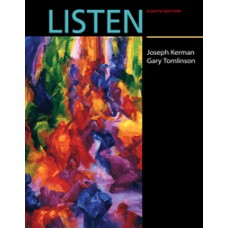Test Bank for Listen, Eighth Edition
$35.00 Original price was: $35.00.$26.50Current price is: $26.50.
Test Bank for Listen, Eighth Edition
Instant download Test Bank for Listen, Eighth Edition pdf docx epub after payment.

Product details:
- ISBN-10 : 0393603644
- ISBN-13 : 978-0393603644
- Author: Joseph Kerman; Gary Tomlinson
Listen makes music accessible to all with its concise historical and cultural context, compelling composer biographies, and clear Listening Charts. The redesigned Eighth Edition incorporates new perspectives on music since 1900, new repertory, and illuminating discussions to help students synthesize the important concepts of classical music and develop the listening skills to explore it further.
Table of contents:
Preface To the Instructor
Introduction To the Student
Classical Music—and Other Kinds
Classical Music and History
Listening
*How to Use This Book
Unit I Fundamentals
CHAPTER 1 Rhythm, Meter, and Tempo
1 Rhythm
Beat and Accent
2 Meter
Rhythm and Meter
Syncopation
Listening Exercise 1 Rhythm, Meter, and Syncopation
3 Tempo
Listening Exercise 2 Rhythm, Meter, and Tempo
*Goals for Review
CHAPTER 2 Pitch, Dynamics, and Tone Color
1 Pitch
2 Dynamics
Listening Exercise 3 Pitch and Dynamics
3 Tone Color
[Box] Musical Instruments
Listening Exercise 4 The Orchestra in Action
*Goals for Review
CHAPTER 3 Scales and Melody
1 Scales
The Octave
The Diatonic Scale
The Chromatic Scale
Half Steps and Whole Steps
2 Melody
Tunes
[Box] Characteristics of Tunes
Listening Exercise 5 Melody and Tune
Motives and Themes
*Goals for Review
CHAPTER 4 Harmony, Texture, Tonality, and Mode
1 Harmony
Consonance and Dissonance
2 Texture
Monophony
Homophony and Polyphony
Imitation
Listening Exercise 6 Texture
3 Tonality and Mode
Tonality
Major and Minor Modes
Keys
Listening for the Major and Minor Modes
Listening for Keys and Modulation
Listening Exercise 7 Mode and Key
*Goals for Review
CHAPTER 5 Musical Form and Musical Style
1 Form in Music
Form and Feeling
Form and Forms
Listening Exercise 8 Musical Form
Musical Genres
2 Musical Style
Musical Style and Lifestyle
Benjamin Britten, The Young Person’s Guide to the Orchestra (1946)
Listening Chart 1
*Goals for Review
UNIT II Early Music: An Overview
*Chronology
CHAPTER 6 The Middle Ages
1 Music and the Church
Music and Church Services: Liturgy
Plainchant
Characteristics of Plainchant
Gregorian Recitation and Gregorian Melody
Anonymous, Plainchant antiphon, “In paradisum” (c. ninth century)
Hildegard of Bingen (1098–1179), Plainchant sequence, “Columba aspexit”
2 Music at Court
Troubadour and Trouvère Songs
Bernart de Ventadorn (c. 1135–1194), Troubadour song, “La dousa votz”
[Box] How Did Early Music Sound?
The Estampie
3 The Evolution of Polyphony
Organum
Pérotin, Organum, “Alleluia. Diffusa est gratia” (c. 1200)
4 Later Medieval Polyphony
Anonymous, Round, “Sumer Is Icumen In” (late thirteenth century)
Ars Nova
Guillaume de Machaut (c. 1300–1377), Chanson, “Dame, de qui toute ma joie vient”
Global Perspectives Sacred Chant
*Goals for Review
CHAPTER 7 The Renaissance
1 New Attitudes
Early Homophony
Guillaume Dufay (c. 1400–1474), Harmonized hymn, “Ave maris stella”
The Mass
2 The High Renaissance Style
Imitation
Homophony
Other Characteristics
Josquin Desprez, Pange lingua Mass (c. 1510)
3 Music as Expression
Josquin Desprez, Chanson, “Mille regrets”
4 Late Renaissance Music
Giovanni Pierluigi da Palestrina, Pope Marcellus Mass (1557)
The Motet
The Italian Madrigal
The English Madrigal
Thomas Weelkes, Madrigal, “As Vesta Was from Latmos Hill Descending” (1601)
5 Instrumental Music: Early Developments
Renaissance Dances
Anonymous (sixteenth century), Galliard, “Daphne”
Anonymous (sixteenth century), “Kemp’s Jig”
Global Perspectives Music and Early European Colonialism
*Goals for Review
CHAPTER 8 The Early Baroque Period
1 From Renaissance to Baroque
Music in Venice
Extravagance and Control
Giovanni Gabrieli (c. 1555–1612), Motet, “O magnum mysterium”
2 Style Features of Early Baroque Music
Rhythm and Meter
Texture: Basso Continuo
Functional Harmony
3 Opera
Recitative
Claudio Monteverdi (1567–1643)
[Box] Singing Italian
Claudio Monteverdi, The Coronation of Poppea (1642)
Henry Purcell (1659–1695)
Henry Purcell, Dido and Aeneas (1689)
4 The Rise of Instrumental Music
Girolamo Frescobaldi (1583–1643)
Girolamo Frescobaldi, Canzona, Balletto, and Corrente (1627–1637)
Global Perspectives African Ostinato Forms
*Goals for Review
UNIT III The Eighteenth Century
*Chronology
CHAPTER 9 Prelude The Late Baroque Period
1 Absolutism and the Age of Science
Art and Absolutism
The Music of Absolutism
Art and Theatricality
Science and the Arts
Science and Music
2 Musical Life in the Early Eighteenth Century
3 Style Features of Late Baroque Music
Rhythm
Dynamics
Tone Color
The Baroque Orchestra
Melody
Ornamentation
Texture
The Continuo
Musical Form
4 The Emotional World of Baroque Music
*Goals for Review
CHAPTER 10 Baroque Instrumental Music
1 Concerto and Concerto Grosso
Movements
Ritornello Form
Antonio Vivaldi, Violin Concerto in G, La stravaganza, Op. 4, No. 12 (1712–1713)
Listening Chart 2
[Biography] Antonio Vivaldi (1678–1741)
Baroque Variation Form: The Ground Bass
Antonio Vivaldi, Violin Concerto in G, La stravaganza, Op. 4, No. 12, second movement
Listening Chart 3
*Vivaldi’s Greatest Hits
*Antonio Vivaldi, Violin Concerto in E, Spring, Op. 8, No. 1 (before 1725)
*Listening Chart 4
Johann Sebastian Bach, Brandenburg Concerto No. 5, for Flute, Violin, Harpsichord, and Orchestra (before 1721)
Listening Chart 5
[Biography] Johann Sebastian Bach (1685–1750)
2 Fugue
Fugal Exposition
Fugal Devices
Johann Sebastian Bach, Prelude and Fugue in C Major, from The Well-Tempered Clavier, Book 1 (1722)
Listening Chart 6
[Box] Glenn Gould (1932–1982)
3 Baroque Dances
The Dance Suite
Baroque Dance Form
George Frideric Handel, Minuet from The Royal Fireworks Music (1749)
Johann Sebastian Bach, Gigue from Cello Suite No. 2 in D Minor (c. 1720)
*Goals for Review
CHAPTER 11 Baroque Vocal Music
1 Opera
Italian Opera Seria
Recitative
Aria
[Box] The Castrato
George Frideric Handel, Julius Caesar (1724)
2 Oratorio
[Biography] George Frideric Handel (1685–1759)
George Frideric Handel, Messiah (1742)
3 The Church Cantata
[Box] Women in Music
The Lutheran Chorale
Johann Sebastian Bach, Cantata No. 4, “Christ lag in Todesbanden” (1707)
*Goals for Review
CHAPTER 12 Prelude Music and the Enlightenment
1 The Enlightenment and Music
“The Pursuit of Happiness”
Art and Entertainment
Jean-Jacques Rousseau and Opera
The Novel
2 The Rise of Concerts
3 Style Features of Classical Music
Rhythm
Dynamics
Tone Color: The Classical Orchestra
Melody: Tunes
Texture: Homophony
Classical Counterpoint
4 Form in Classical Music
Repetitions and Cadences
Classical Forms
*Goals for Review
CHAPTER 13 The Symphony
1 The Movements of the Symphony
2 Sonata Form
Exposition (A)
Development (B)
Recapitulation (A′)
Wolfgang Amadeus Mozart, Symphony No. 40 in G Minor, K. 550 (1788)
Listening Chart 7
[Biography] Wolfgang Amadeus Mozart (1756–1791)
3 Classical Variation Form
*Symphonies of Haydn
*Franz Joseph Haydn, Symphony No. 94 in G (“The Surprise”) (1791)
*Listening Chart 8
[Biography] Franz Joseph Haydn (1732–1809)
4 Minuet Form (Classical Dance Form)
Baroque and Classical Dance Form
*Franz Joseph Haydn, Symphony No. 99 in E-flat (1793)
*Listening Chart 9
5 Rondo Form
*Franz Joseph Haydn, Symphony No. 101 in D (“The Clock”) (1793–1794)
*Listening Chart 10
*Goals for Review
CHAPTER 14 Other Classical Genres
1 The Sonata
2 The Classical Concerto
Double-Exposition Form
Wolfgang Amadeus Mozart, Piano Concerto No. 23 in A, K. 488 (1786)
Listening Chart 11
3 The String Quartet
Chamber Music
4 Opera Buffa
The Ensemble
Wolfgang Amadeus Mozart, Don Giovanni (1787)
Global Perspectives Musical Form: Two Case Studies from Asia
*Goals for Review
UNIT IV The Nineteenth Century
*Chronology
CHAPTER 15 Beethoven
1 Between Classicism and Romanticism
The French Revolution
2 Beethoven and the Symphony
[Biography] Ludwig van Beethoven (1770–1827)
Ludwig van Beethoven, Symphony No. 5 in C Minor, Op. 67 (1808)
Listening Chart 12
Listening Chart 13
3 Beethoven’s “Third Period”
*Ludwig van Beethoven, Piano Sonata in E, Op. 109 (1820)
*Listening Chart 14
*Goals for Review
CHAPTER 16 Prelude Music after Beethoven: Romanticism
1 Romanticism
The Cult of Individual Feeling
Romanticism and Revolt
Artistic Barriers
Music and the Supernatural
Music and the Other Arts
2 Concert Life in the Nineteenth Century
The Artist and the Public
3 Style Features of Romantic Music
Romantic Melody
Romantic Harmony
Rhythmic Freedom: Rubato
The Expansion of Tone Color
4 Program Music
5 Form in Romantic Music
Miniature Compositions
Grandiose Compositions
The Principle of Thematic Unity
*Goals for Review
CHAPTER 17 The Early Romantics
1 The Lied
Franz Schubert, “Erlkönig” (The Erlking) (1815)
[Biography] Franz Schubert (1797–1828)
The Song Cycle
Robert Schumann, Dichterliebe (A Poet’s Love) (1840)
[Biography] Robert Schumann (1810–1856)
Clara Schumann, “Der Mond kommt still gegangen” (The moon has risen softly) (1843)
[Biography] Clara Wieck (Clara Schumann) (1819–1896)
2 The Character Piece for Piano
Franz Schubert, Moment Musical No. 2 in A-flat (1827?)
Robert Schumann, Carnaval (1833–1835)
Frédéric Chopin, Nocturne in F-sharp, Op. 15, No. 2 (1831)
[Biography] Frédéric Chopin (1810–1849)
[Biography] Franz Liszt (1811–1886)
3 Early Romantic Program Music
The Concert Overture: Felix Mendelssohn
[Biography] Felix Mendelssohn (1809–1847)
[Biography] Fanny Mendelssohn (1805–1847)
The Program Symphony: Hector Berlioz
Hector Berlioz, Fantastic Symphony: Episodes in the Life of an Artist (1830)
Listening Chart 15
[Biography] Hector Berlioz (1803–1869)
*Goals for Review
CHAPTER 18 Romantic Opera
1 Verdi and Italian Opera
Recitative and Aria: The Role of the Orchestra
[Box] Early Romantic Opera
Giuseppe Verdi, Rigoletto (1851)
[Biography] Giuseppe Verdi (1813–1901)
2 Wagner and Music Drama
[Biography] Richard Wagner (1813–1883)
The Total Work of Art
Leitmotivs
[Box] Wagner’s Tristan and Isolde (1859)
The Nibelung’s Ring (1848–1874)
Richard Wagner, The Valkyrie (1851–1856)
3 Late Romantic Opera
Giacomo Puccini (1858–1924)
Giacomo Puccini, Madame Butterfly (1904)
*Goals for Review
CHAPTER 19 The Late Romantics
Romanticism and Realism
1 Late Romantic Program Music
Pyotr Ilyich Tchaikovsky, Overture-Fantasy, Romeo and Juliet (1869, revised 1880)
Listening Chart 16
[Biography] Pyotr Ilyich Tchaikovsky (1840–1893)
2 Nationalism
Exoticism
The Russian Kuchka
Modest Musorgsky, Pictures at an Exhibition (1874)
[Biography] Modest Musorgsky (1839–1881)
[Box] Other Nationalists
3 Responses to Romanticism
The Renewal of Classicism: Brahms
[Biography] Johannes Brahms (1833–1897)
Johannes Brahms, Violin Concerto in D, Op. 77 (1878)
Listening Chart 17
Romantic Nostalgia: Mahler
[Biography] Gustav Mahler (1860–1911)
Gustav Mahler, Symphony No. 1 (1888)
Listening Chart 18
Global Perspectives Musical Drama Worldwide
*Goals for Review
People also search:
Listen, Eighth Edition
Listen, Eighth Edition pdf
Listen
|
listen about meaning
|
|
||||||
listening about personality











